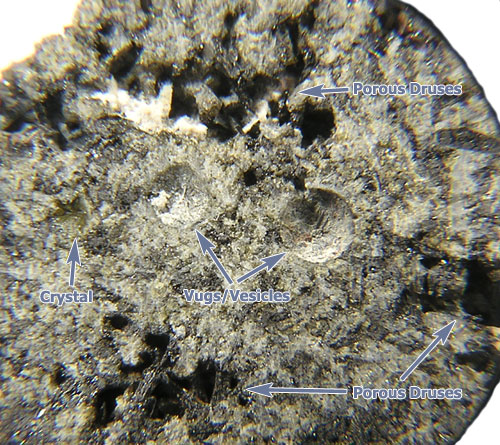S
silylene
Guest
I was reading the intertesting article in Nature about the recent 2008 TC3 meteorite fall in Africa, and the discovery that there were vugs in these meteorites, one of which had crystals on its interior surface. 2008 TC3 was an unusual carbon rich meteorite, a ureilite. See article below:
http://www.skyandtelescope.com/community/skyblog/newsblog/41873107.html
See figure 3C from the Nature paper for a vug with crystals, if you can open this without paying the fee: http://www.nature.com/nature/journal/v458/n7237/abs/nature07920.html
Not being a geologist, nor a meteorite person, I was previously unaware that vugs are sometimes (rather rarely) found inside meteorites, and that more rarely meteoric vugs can even have surfaces decorated with crystals. I was doing some background reading and found that vugs have been seen in some other meteorites, chronditic and achronditic types (and bizarrely vugs were also found in the iron Albion meteorite), and also in a rock suspected of coming from Mars.
I was wondering:
1) how do these meteorite vugs form?
2) are any of the vugs in meteorites formed from water inclusions?
3) has anyone ever collected and analyzed a sample of pristine gas from inside one of the vugs?
picture of vugs from the d'orbigny meteorite:

background, along with a few papers on this stone:
http://www.meteorites.com.au/features/d'orbigny.html
http://www.skyandtelescope.com/community/skyblog/newsblog/41873107.html
See figure 3C from the Nature paper for a vug with crystals, if you can open this without paying the fee: http://www.nature.com/nature/journal/v458/n7237/abs/nature07920.html
Not being a geologist, nor a meteorite person, I was previously unaware that vugs are sometimes (rather rarely) found inside meteorites, and that more rarely meteoric vugs can even have surfaces decorated with crystals. I was doing some background reading and found that vugs have been seen in some other meteorites, chronditic and achronditic types (and bizarrely vugs were also found in the iron Albion meteorite), and also in a rock suspected of coming from Mars.
I was wondering:
1) how do these meteorite vugs form?
2) are any of the vugs in meteorites formed from water inclusions?
3) has anyone ever collected and analyzed a sample of pristine gas from inside one of the vugs?
picture of vugs from the d'orbigny meteorite:

background, along with a few papers on this stone:
http://www.meteorites.com.au/features/d'orbigny.html


